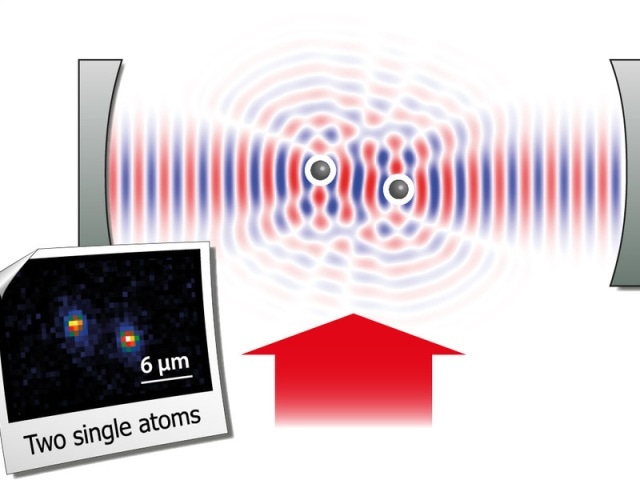Mar 1 2016
The investigation and exploitation of light-matter-interaction in optical resonators is one of the central research topics in the Quantum Dynamics Division of Professor Gerhard Rempe, Director at the Max Planck Institute of Quantum Optics in Garching. A couple of years ago, the team succeeded in creating single-photon emitters using single atoms stored in optical resonators.
The stationary atoms can, for example, serve as nodes for the exchange of quantum information in a long-distance quantum network. Now, the scientists went one step further. They trapped a pair of atoms with well-defined relative positions in such a resonator and scattered light from this “double slit”. They observed interference phenomena that contradict well-established intuition. These results were enabled by the development of a technique that allows for position control of the atoms with an accuracy well below the wavelength of the scattered light. One motivation for this experiment is to better understand fundamental aspects of cavity quantum electrodynamics. Furthermore, the technique paves the way for studying new concepts of entanglement generation between quantum bits and thus opens up new perspectives for quantum information processing (Nature Photonics, AOP, 29 February 2016, DOI:10.1038/nphoton.2016.19).
 Resonant laser light (red arrow) is being scattered from two single atoms. The effects that arise due to interference (here shown in an artist’s view) are determined by the relative spatial phase of the atoms and the interaction with the light mode of the optical resonator (mirrors in grey). Lower left: fluorescence image of two rubidium atoms.Credits: Andreas Neuzner, MPQ, Quantum Dynamics Division
Resonant laser light (red arrow) is being scattered from two single atoms. The effects that arise due to interference (here shown in an artist’s view) are determined by the relative spatial phase of the atoms and the interaction with the light mode of the optical resonator (mirrors in grey). Lower left: fluorescence image of two rubidium atoms.Credits: Andreas Neuzner, MPQ, Quantum Dynamics Division
Key element of the experimental set-up is an optical resonator consisting of two highly-reflecting mirrors spaced by 0.5 mm. Inside the cavity, a so-called optical lattice is generated by crossing two retro-reflected laser beams, one oriented orthogonal to and the other along the resonator axis. The resulting light pattern of bright and dark spots resembles a checker board with a period of about half a micrometre. These spots define lattice sites at which the atoms can be trapped and where they are localized to about 25 nanometres.
At first, a couple of rubidium atoms, precooled to very low temperatures, are loaded into the optical lattice. By detecting their fluorescence light via a high-resolution microscope objective, the atoms can be identified as individual light spots. Excess atoms are subsequently removed by individually heating them up with a resonant laser beam, until only a pair of atoms with the desired spacing remains. “This is the “double-slit” from which the resonant laser light, propagating transversally through the resonator, is scattered”, explains Andreas Neuzner, who performed this experiment as part of his doctoral studies.
"Interference can only be observed if the phase relation between the two light sources is fixed“, explains Dr. Stephan Ritter, another scientist on the experiment. “In order to investigate the interference as a function of the phase, we have to know the position of the atoms with a precision well below the wavelength of 780 nanometres.“ Although the resolution of the imaging system limits the size of the atom images to 1.3 micrometres, the scientists can localize the emitting atoms with an accuracy of 70 nanometres and can thereby assign their position to a particular lattice site. Therefore, the distance between two atoms, typically about 10 micrometres, is precisely known.
The resonator favours emission along its axis and enhances the interaction between the atoms and the scattered light, which is reflected multiple times between the mirrors. The light power leaking through one of the mirrors – i.e. the photon rate – is recorded as a function of the relative phase of the two atoms.
The observed interference pattern displays several intriguing features that are not expected in the simpler picture of two classical dipoles in free space. First, in the case of in-phase (constructive) interference, the intensity is only a factor of 1.3 larger than the rate observed for a single atom, whereas a fourfold larger signal is expected for the simpler picture. This phenomenon goes back to the various light fields inside the resonator that have to be taken into account. In contrast to the classical double-slit experiment, not only the phase relation between the scattered light waves matters. It is rather the superposition of the scattered light with the light field of the resonator that in the end leads to an intensity reduction in the field maxima.
The second feature occurs for out-of-phase (destructive) interference. Here, the photon rate drops below the value measured for a single atom, but does not go to zero as one would expect intuitively. Strikingly, extremely strong intensity fluctuations are observed, so-called photon bunching. “This phenomenon arises, because in the case of destructive interference, the atoms can emit photons only pairwise and at the same time into the resonator”, explains Andreas Neuzner.
"In this experiment we have combined three key techniques for the first time: Using an optical lattice, we position the atoms with high accuracy and then localize them with a high-resolution microscope. The interaction with the resonator enables directed detection of the scattered light“, says Stephan Ritter. “The newly developed techniques are essential for future experiments aiming to explore collective radiation effects predicted for multi-atom systems“, resumes Prof. Gerhard Rempe. “On the other hand, they offer the possibility to implement novel protocols for quantum information processing with several quantum bits.” Olivia Meyer-Streng